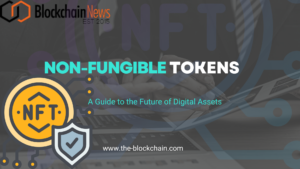Non-fungible tokens (NFTs) are a type of digital asset that is unique and cannot be replaced. They are created using blockchain technology, which is the same technology that powers cryptocurrencies like Bitcoin and Ethereum. NFTs can represent anything from digital artwork to in-game items to real estate.
What are NFTs?
The term “non-fungible” means that something is unique and cannot be replaced. For example, a bitcoin is fungible, meaning that one bitcoin is interchangeable with another bitcoin. However, an NFT is non-fungible, meaning that each NFT is unique and cannot be replaced with another NFT.
NFTs are created using blockchain technology. Blockchain is a distributed ledger that records transactions in a secure and transparent way. When an NFT is created, its unique identifier and metadata are recorded on the blockchain. This makes it possible to verify the authenticity and ownership of an NFT.
How do NFTs work?
NFTs work by using a token standard called ERC-721. ERC-721 is a smart contract standard that allows for the creation of unique and non-interchangeable tokens on the Ethereum blockchain. When an NFT is created, it is assigned a unique identifier and metadata. The metadata can include information about the NFT, such as its creator, the date it was created, and its price.
NFTs can be bought and sold on NFT marketplaces. These marketplaces are similar to online auction houses, where buyers and sellers can trade NFTs. When an NFT is bought or sold, the transaction is recorded on the blockchain. This makes it possible to track the ownership history of an NFT.
What are the benefits of NFTs?
There are several benefits to using NFTs. First, NFTs are unique and cannot be replaced. This makes them ideal for representing digital assets that are also unique, such as digital artwork or in-game items. Second, NFTs use blockchain technology, which is a secure and transparent way to record transactions. This makes it possible to verify the authenticity and ownership of an NFT. Third, NFTs can be easily traded on NFT marketplaces. This makes them a liquid asset that can be easily bought and sold.
What are the risks of NFTs?
There are also some risks associated with NFTs. First, NFTs are still a new technology, and there is some risk of fraud. Second, NFTs are often bought and sold using cryptocurrencies, which are also volatile assets. This means that the value of an NFT can fluctuate wildly. Third, NFTs are not regulated by any government or financial institution. This means that there is no guarantee of their value or safety.
Conclusion
NFTs are a new and innovative technology with the potential to revolutionize the way we own and trade digital assets. However, there are also some risks associated with NFTs, and it is important to do your research before investing in them.
Here are some of the potential applications of NFTs:
- Digital art: NFTs can be used to represent digital artwork, such as paintings, photographs, and music. This could make it easier to buy, sell, and trade digital artwork.
- In-game items: NFTs can be used to represent in-game items, such as weapons, armor, and pets. This could make it easier to trade and sell in-game items.
- Real estate: NFTs can be used to represent real estate, such as houses, apartments, and land. This could make it easier to buy, sell, and invest in real estate.
- Tickets: NFTs can be used to represent tickets to events, such as concerts, sporting events, and theater shows. This could make it easier to buy, sell, and transfer tickets.
- Identity: NFTs can be used to represent a person’s identity, such as their driver’s license or passport. This could make it easier to verify a person’s identity online.
The future of NFTs is still uncertain, but they have the potential to revolutionize the way we own and trade digital assets. Only time will tell how NFTs will be used in the years to come.



